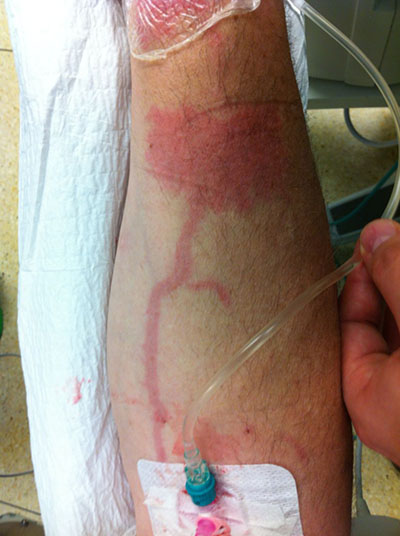
Phlebitis, also known as venitis, is inflammation of a vein. It is a condition that affects the veins, which are blood vessels that carry blood back to the heart. When a vein becomes inflamed, it can become red, swollen, and painful. Phlebitis can also cause the vein to harden, making it difficult for blood to flow through it. Phlebitis can occur in any vein in the body, but it is most common in the legs. It commonly occurs in superficial veins. It is also usually caused by a blood clot, and is therefore also called thrombophlebitis.
Causes
Phlebitis is most often caused by local trauma to a vein, such as from the insertion of an IV catheter. However, it can also occur as a complication of connective tissue disorders like lupus, or of pancreatic, breast, or ovarian cancers. Additionally, phlebitis can be caused by certain medications and drugs that irritate the veins, such as desomorphine.
Risk Factors
- Prolonged inactivity
- Sedentary lifestyle
- Obesity
- Smoking cigarettes
- Certain medical conditions, such as cancer or blood disorders, that increase the clotting potential of the blood
- Injury to your arms or legs
- Hormone replacement therapy or birth control pills
- Pregnancy
- Varicose veins
Signs and Symptoms
The most common symptoms of phlebitis are:
- Pain, tenderness, and swelling in the affected area
- Redness and warmth of the skin over the affected vein
- A hard, cord-like feel under the skin
In some cases, phlebitis may also cause fever and chills.
Phlebitis usually starts slowly with a tender, red area along the superficial veins of the skin. A long, thin red line following a superficial vein may also be visible. The affected area may feel hard, warm, and tender. The skin around the vein may be itchy and swollen. The area may throb or burn. Symptoms may worsen when the leg is lowered, especially when first getting out of bed in the morning. A low-grade fever may also occur. Sometimes, phlebitis may occur at the site where a peripheral intravenous line was inserted. The surrounding area may be sore and tender along the vein.
Diagnosis
To diagnose phlebitis, a doctor will typically begin with a physical examination and ask about the patient's symptoms. The doctor will look for signs of inflammation, such as redness, swelling, and tenderness, along the affected vein. The doctor may also feel for a hard cord along the vein, which is a sign of a blood clot.
If the doctor suspects phlebitis, they may order one or more diagnostic tests, such as:
- Blood tests: Blood tests can be used to check for signs of inflammation and infection. They can also be used to check for other conditions that can cause symptoms similar to phlebitis, such as deep vein thrombosis (DVT).
- Ultrasound: An ultrasound is a non-invasive imaging test that uses sound waves to create pictures of the veins. It can be used to check for blood clots in the veins and to measure the blood flow through the veins.
- Venogram: A venogram is an X-ray of the veins that uses a contrast dye to make the veins more visible. It is a more invasive test than an ultrasound, but it can be more accurate at detecting blood clots in smaller veins.
In some cases, the doctor may also order other tests, such as an MRI or CT scan, to get a better look at the veins or to rule out other conditions.
Once the doctor has diagnosed phlebitis, they will recommend a treatment plan based on the severity of the condition and the underlying cause.
Prevention
There are a number of things you can do to prevent phlebitis, including:
- Avoid sitting or lying down for long periods of time
- Get regular exercise
- Maintain a healthy weight
- Avoid smoking
- Treat any underlying medical conditions, such as cancer, heart disease, and diabetes
Nursing Interventions
- Monitor the affected area for signs of infection: These include redness, warmth, swelling, and pain. If any of these signs are present, notify the doctor immediately.
- Apply alternating hot and cold compress: Heat can help to reduce pain and inflammation, while cold can help to reduce swelling.
- Elevate the affected extremity above the level of the heart: This can be done by placing a pillow under the extremity when sitting or lying down.
- Encourage the patient to move around regularly: This helps to prevent blood clots from forming.
- Provide the patient with pain medication as needed: Over-the-counter pain relievers, such as ibuprofen or acetaminophen, are usually effective. If these are not effective, the doctor may prescribe stronger pain medication.
- Educate the patient about phlebitis and how to prevent it: This includes teaching the patient about the importance of rest, elevation, and compression. It is also important to teach the patient about the signs and symptoms of infection and when to seek medical attention.
Treatment
Treatment for phlebitis depends on the severity of the condition and the underlying cause. In most cases, phlebitis can be treated at home with over-the-counter pain relievers and compression stockings. Compression stockings help to reduce swelling and pain.
If the phlebitis is severe or caused by a blood clot, the doctor may prescribe blood thinners or other medications such as anti-inflammatory medications. In some cases, surgery may be necessary to remove the blood clot.
Complications
- Local infection and abscess formation
- Clot formation
- Progression to deep venous thrombosis (DVT) and pulmonary embolism
- Post-phlebitic syndrome
- Infection in the clotted veins, which is associated with high fever, and redness that extends well past the affected vein